Indoor Herb Gardening: A Complete Care Guide
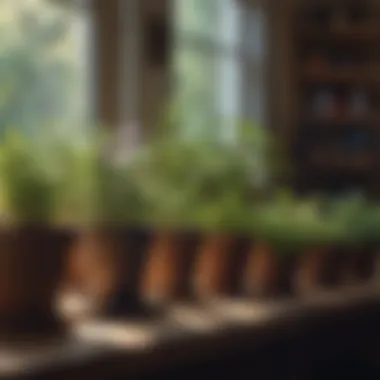
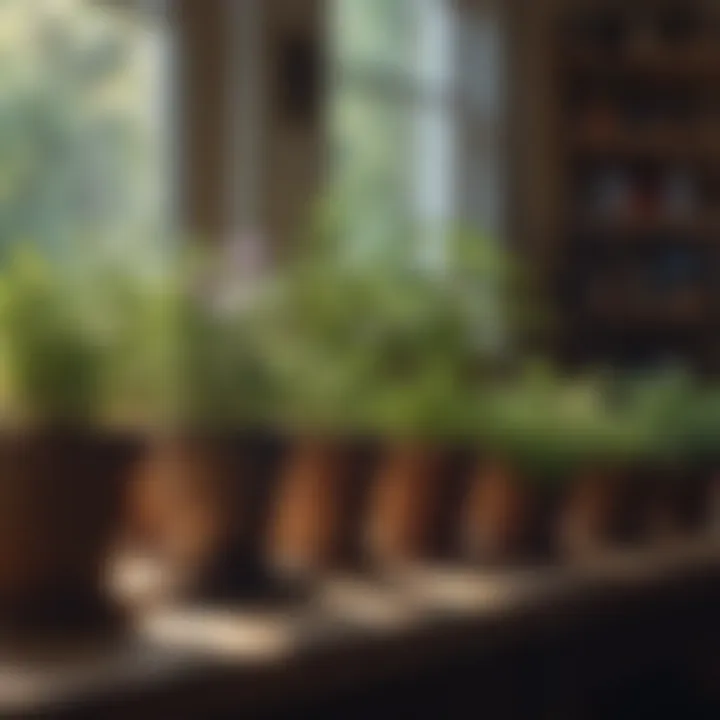
Intro
Growing herbs indoors adds life to any space, and the pleasure of having fresh, fragrant herbs at your fingertips is unmatched. Whether you lean toward cooking with basil, garnishing with chives, or invigorating your home with mint, the possibilities are as vibrant as the plants themselves. An indoor herb garden not only beautifies your environment but also contributes to a healthier lifestyle by promoting self-sustainable gardening practices.
In this guide, we’ll explore the essential elements necessary for successful indoor herb cultivation. This includes insight into selecting the right herb varieties to suit your space, understanding the importance of light exposure, mastering watering techniques, and recognizing soil needs. Additionally, the discussion will extend to pest management, tools and equipment needed for an indoor garden, as well as common pitfalls to avoid.
As we delve deeper, you'll discover how nurturing herbs can transcend mere culinary use, transforming your living area into a mini-ecosystem. While a single pot on a windowsill may seem modest, multiple varieties can create a compact green haven, enriching your life with scents and flavors that improve your well-being. Let's dig into the nitty-gritty of this rewarding hobby.
Preface to Indoor Herb Gardening
Indoor herb gardening has carved itself a special niche in the world of horticulture. Unlike the sprawling outdoor gardens most people envision, growing herbs indoors speaks to both practicality and charm. It is not just about enhancing culinary endeavors; it’s a way of putting fresh, flavorful, and essential greens right at your fingertips. Living in a space that promotes wellness and vitality can be invigorating, and indoor herbs add to this ambiance beautifully.
Understanding Indoor Gardening
Indoor gardening might initially seem straightforward, but it carries unique challenges compared to tending a garden outside. The first major distinction is the environment—indoor spaces often lack consistent light and varying temperatures. Also, the air circulation is not quite the same. Without proper attention to light sources, your herbs may end up stretching toward the nearest window—or even worse, becoming leggy and unhealthy.
When opting for herbs, it’s crucial to select varieties that are suited for confined spaces. Think about how each herb utilizes light, moisture, and nutrients. Some herbs, such as basil and cilantro, require more attention than others, making it essential for aspiring gardeners to do their homework before diving in. Overall, understanding the dynamics of indoor gardening is the foundation of growing lush and fragrant herbs right in your kitchen.
Importance of Herbs in Daily Life
Herbs serve as more than mere decorative plants; they are integral to enriching our meals and overall well-being. Take basil, for example. Known for its aromatic leaves, this herb not only elevates a typical pasta dish but also boasts medicinal properties, aiding digestion and reducing inflammation. Similarly, rosemary has a delightful scent and is associated with memory enhancement.
Moreover, having fresh herbs at home can change how one approaches cooking. You’re more inclined to whip up a meal on a whim when fresh ingredients are within arm's reach. Today’s fast-paced lifestyle often leads individuals to rely on pre-packaged seasoning that lacks the freshness of homegrown herbs. Instead of bland and boring, imagine transforming your culinary creations into delightful experiences that burst with flavor.
In essence, indoor herb gardening nurtures a relationship with nature, encourages healthier eating habits, and adds a personal touch to dishes. With each sprig harvested, you are reminded of the care that went into its growth and the richness it brings to your life.
Choosing the Right Herbs for Indoor Growth
Choosing the right herbs for indoor growth is like picking the right shoes for a big event; the wrong choice can lead to discomfort, or in this case, a crop that doesn’t thrive. The essence of indoor herb gardening starts with understanding which herbs are suited to the environment inside your home. Factors such as light availability, space constraints, and humidity will guide your selection. Some herbs flourish in busy kitchens, while others prefer quieter nooks away from foot traffic.
Including herbs that suit your culinary habits or preferences also adds a personal touch to your indoor garden. Imagine snipping fresh basil for that pasta or adding chives to a bland dish—these herbs enhance flavors and promote creativity in the kitchen. Hence, selecting the right herbs goes beyond mere aesthetics; it’s about enriching your daily life with fresh and accessible flavors.
"The right herbs can turn any space into a vibrant oasis, breathing life into your routines and meals."
Popular Herbs for Indoor Cultivation
When diving into the world of indoor herbs, it's essential to know which kinds are the most popular and easiest to cultivate. Herbs such as basil, parsley, mint, and thyme often find themselves at the top of the list.
- Basil: This herb loves sunlight and warmth, making it perfect for kitchens with a south-facing window. It grows quickly and can become quite bushy if pruned correctly.
- Parsley: Versatile and packed with nutrients, parsley can thrive in both bright light and partial shade. It's a great choice for those without direct sunlight all day.
- Mint: Mint is robust and can spread vigorously if not managed. Because of its hardy nature, it can do well with less light than other herbs, still giving you that refreshing taste.
- Thyme: Low-maintenance and drought-tolerant, thyme adapts well to indoor settings. It's perfect for those who might forget to water occasionally.
These options not only provide a good learning curve for novice gardeners but also contribute to a flavorful assortment for culinary experiments.
Herb Growth Rate and Maintenance Needs
Understanding the growth rate of your chosen herbs is vital in determining the care regime you'll need to follow. Some herbs sprout quickly, often ready for harvesting within weeks, while others take longer to show their faces.
For instance, basil typically takes about 4 to 6 weeks to reach a height ready for snipping. Conversely, rosemary can take months to reach its prime, which means patience is key.
Moreover, maintenance needs vary:
- Light: Most herbs thrive with 6-8 hours of light per day. Ensure they get adequate exposure, whether from windows or grow lights.
- Watering: Regular watering schedules are essential, but ensure you don’t drown them. It’s best to let the topsoil dry between watering; that helps develop deep roots.
- Fertilization: Using a balanced fertilizer every few weeks can help maintain vigorous growth. Look for low-nitrogen fertilizers—herbs generally prefer less nitrogen than leafy vegetables.
By keeping an eye on these factors, you'll foster a healthier environment for your herbs, turning your indoor space into a flourishing herb garden.
Ideal Growing Conditions for Indoor Herbs
Creating a thriving indoor herb garden hinges significantly on establishing the proper growing conditions. When we talk about ideal growing conditions, we’re focusing on the right balance of light, temperature, and humidity—three foundational elements that will determine the success of your indoor herbs. Achieving these conditions not only fosters healthy growth but also ensures that your herbs are flavorful and robust, enhancing their use in culinary applications.
A well-thought-out approach to these conditions helps you avoid common pitfalls, such as leggy plants that stretch for light or herbs that bolt prematurely due to stress. Moreover, the satisfaction of nurturing lush, green herbs that elevate your dishes makes the effort worth it.
Assessing Light Requirements
In the world of indoor gardening, light is the lifeblood of your plants. Assessing the light requirements of each herb you grow is foundational because it directly impacts their growth and vitality.
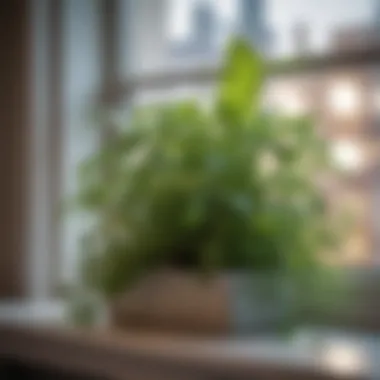
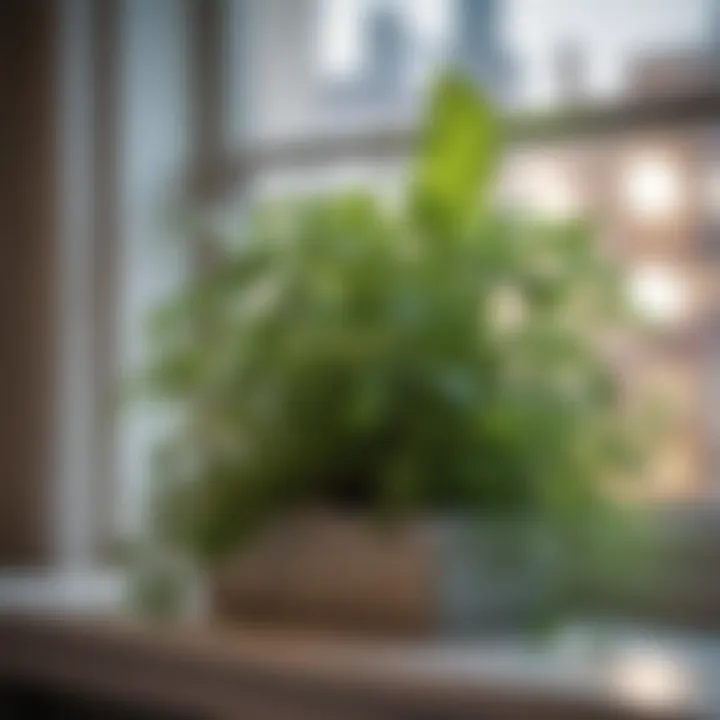
Natural Light vs. Artificial Grow Lights
One of the pivotal choices you will face is whether to rely on natural light or to utilize artificial grow lights.
Natural light is typically free and abundant in the right conditions. Placing your herbs by a south-facing window, for instance, can give them plenty of sunlight throughout the day. However, seasons can change, and during the shorter days of winter, your herbs might not get sufficient sunlight, leading to compromised growth.
"For many herbs, six to eight hours of direct sunlight is ideal to truly flourish."
On the flip side, artificial grow lights provide a controlled environment. These lights can be tailored to mimic the sun’s spectrum, making them a popular choice among indoor gardeners. Although there’s an initial investment involved, and electricity costs can pile up, they offer consistency. For example, LED grow lights consume less energy and have longer lifespans, making them economically sound over time.
Both options have their upsides and downsides. The unique features of these methods depend on your living situation and your commitment to caring for your plants. For some, the aesthetic aspect of natural light can turn a window into a beautiful herb display, while others may prioritize the predictability provided by grow lights.
Optimal Temperature and Humidity Levels
Temperature and humidity work hand in hand to cultivate an environment where herbs can thrive. Most herbs prefer a comfortable indoor temperature range, typically between 65°F to 75°F.
Keeping the temperature steady is vital; sudden drops or increases can stress your plants, leading to slower growth or disease. Moreover, herbs grown indoors tend to need higher humidity than what typical indoor air provides, especially in winter when heating runs.
A dedicated humidifier can help ease these conditions, or you might consider simple tricks like placing a water tray with pebbles under your pots—this will help with moisture retention in the air surrounding your plants. It's also worth noting that some herbs, like basil, flourish with higher humidity, while others, such as rosemary, prefer drier air.
Balancing these elements and adjusting them according to specific herb needs aids in maximizing growth potential. Every herb might not demand the same environment, but meeting their overall needs is the key to a productive indoor garden.
Soil and Container Considerations
Taking care of indoor herbs goes beyond simply watering and providing sunlight; the foundation of a thriving herb garden lies in the soil and containers you choose. The right soil ensures that your plants receive essential nutrients, while appropriate containers play a crucial role in drainage and growth conditions.
Using the proper soil mix supports healthy root development and minimizes the risk of diseases that can afflict your plants. Additionally, the choice of container can significantly influence your herbs' access to air and water. Getting these aspects right lays a solid groundwork for your indoor gardening venture.
Selecting the Right Soil Type
When it comes to indoor herb gardening, not any old dirt will do. Herbs require a well-draining soil that caters specifically to their nutrient needs. Ideally, a mix of potting soil, perlite, and organic compost works wonders. Here’s why this combination is a hit:
- Well-draining Capability: Mixing perlite ensures that excess water drains away, preventing root rot, a nightmare for any plant lover.
- Nutrient-rich: Organic compost boosts soil quality, providing essential nutrients that herbs crave.
- Acidity Levels: Most herbs thrive in slightly acidic to neutral soil (pH 6.0-7.0), so opt for a soil mix that naturally falls into this range.
It's also ill-advised to use garden soil from outdoors, as it often leads to pests or diseases directly into your living space. Remember, quality over quantity is the name of the game here.
Container Size and Drainage Importance
The size of your container can make or break your herbs. A pot that’s too small restricts root growth, leading to stagnant plants. Conversely, too large a pot can hold excessive moisture, creating ideal conditions for root rot. Instead, choose containers that are just a couple of inches larger than the root ball of your herb plants.
- Finding the Right Balance: A general rule of thumb is to select pots at least 6 to 8 inches in diameter for most common indoor herbs.
- Importance of Drainage Holes: Ensure that your containers have drainage holes at the bottom. This allows water to escape, which is critical since herbs prefer moist but not soggy soil.
Material Considerations for Pots
The material of your pots forms an integral part of both aesthetics and functionality. Clay, ceramic, and plastic are the most common materials. Each has its pros and cons:
- Clay Pots: Known for their breathability, clay pots promote airflow to the roots. However, they can dry out quickly, necessitating more frequent watering.
- Ceramic Pots: Often glazed, these containers are both beautiful and effective in retaining moisture, reducing the need for daily checks on water levels. But, ensure they have drainage holes.
- Plastic Pots: Lightweight and convenient, plastic pots help in retaining moisture. Nevertheless, keep an eye out for rot, as they don’t breathe as well as other materials.
Key Characteristic: When selecting pots, consider not just appearance but functionality. The right pot will not only carry your plants but also promotes their growth, ultimately leading to a lush indoor herb garden.
The unique features and advantages of each material can enhance your indoor garden while addressing varying care needs of each herb you grow.
Creating an indoor herb garden is a delicate balancing act, where the right soil and container choices pave the way for strong, healthy herbs, ready to elevate your culinary creations.
Watering Practices for Indoor Herbs
Proper watering is one of the cornerstones of successful indoor herb gardening. Herbs are often more delicate than one may assume, requiring a careful balance of moisture. Too little water can cause stunted growth and leaf wilting, while too much can lead to root rot. Understanding how to effectively water herbs ensures that they thrive, producing flavorful leaves that will enhance culinary creations. This section will delve deep into the subtleties of watering practices, laying the groundwork for a lush indoor herb garden.
Understanding Water Needs of Different Herbs
Each herb comes with its own distinct water needs. Recognizing these differences helps in catering to each plant's specific requirements, increasing success in cultivation. For instance, basil tends to enjoy a slightly moist environment, needing regular watering to maintain its vibrant green leaves. On the other hand, rosemary, a semi-arid plant, prefers its soil to dry out between waterings, making it more resistant to over-watering.
Here is a breakdown of some common indoor herbs and their water needs:
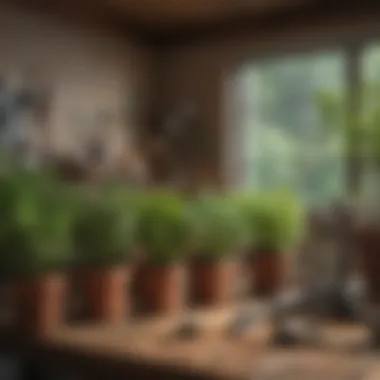
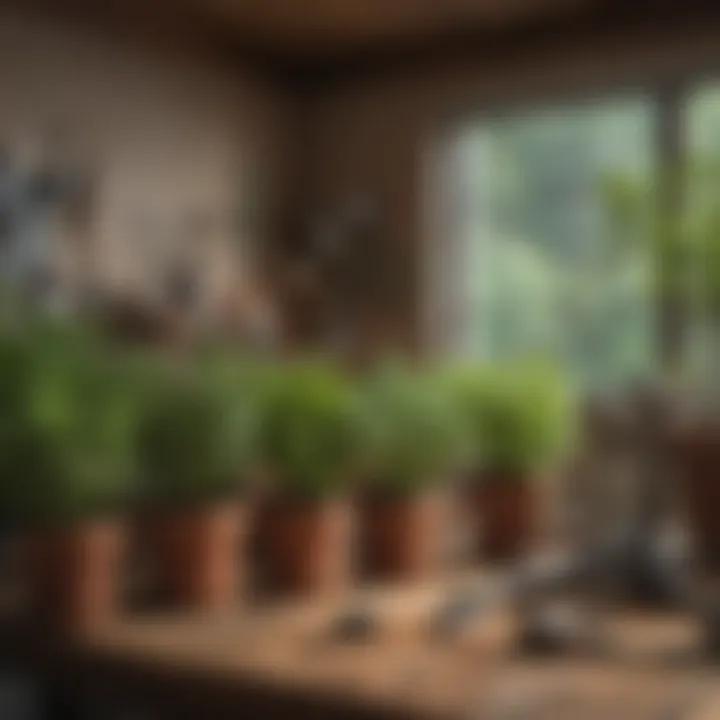
- Basil: Likes evenly moist soil; water when the top inch of soil feels dry.
- Mint: Thrives in consistently moist soil; regular checks are advised.
- Thyme: Prefers to dry out between waterings; keep an eye on its leaves.
- Cilantro: Will grow best in moderately moist soil; a balance is key.
Understanding these needs can aid gardeners in creating not only a healthier plant but also a more sustainable growing environment. Failing to recognize the unique requirements of each herb may lead to frustration and disappointment, but awareness fosters better practice.
Proper Watering Techniques and Schedules
Employing the right watering techniques is critical for ensuring the longevity and health of indoor herbs. Here are a few pointers worth noting:
- Check the Soil: Always stick your finger about an inch into the soil to gauge moisture levels before watering.
- Water Slowly and Evenly: When you do water, do it slowly. This allows the soil to absorb moisture more efficiently. Pour water directly onto the soil rather than onto the plant leaves to minimize the risk of mold.
- Use Quality Water: Tap water can contain chemicals harmful to plants. Consider using filtered or rainwater when possible.
- Be Mindful of Season Changes: Indoor environments can change drastically with seasons. In winter, when humidity levels are typically lower, you may find yourself needing to water more often.
- Create a Schedule: Developing a consistent watering routine can be beneficial. For example, you might set a day each week to check on your herbs, adjusting based on their specific requirements.
"Water management in gardening is an art. A skilled gardener recognizes that patience is as crucial as understanding their plants' needs."
By taking care to follow these techniques, you can maintain a healthier and more vibrant indoor herb garden. Regularly monitoring the condition of your plants and adjusting your watering schedule accordingly can make all the difference in keeping them thriving in your home.
Nutrient Management for Healthy Growth
Managing nutrients for indoor herbs is crucial to ensure strong growth, vibrant flavor, and a healthy plant. In a confined space like your home, herbs don’t have access to the natural soil ecosystem full of microbes and nutrients that they might find outdoors. Understanding and addressing their nutritional needs is fundamental. When you give your herbs the right kind of foods, they thrive, producing better yields and flavors that can elevate your culinary experience.
Identifying Nutritional Needs of Herbs
Each herb has its own set of nutritional requirements, which can vary based on its growth stage, species, and environmental conditions. Generally, herbs need a mix of macronutrients and micronutrients. Here are the essentials:
- Nitrogen (N): Vital for leaf growth and overall vigor.
- Phosphorus (P): Important for strong root systems and flower development.
- Potassium (K): Enhances the plant's resilience against disease and helps with the synthesis of proteins and sugars.
- Calcium, Magnesium, and Sulfur: Micronutrients that aid in various physiological processes in plants.
To check if your herbs are getting what they need, look for signs of nutrient deficiency. Yellowing leaves often indicate a nitrogen deficit, whereas stunted growth or weak stems can signal a lack of potassium. Keeping a close eye on these indicators allows you to adapt your fertilization approach accordingly.
Choosing Appropriate Fertilizers
When it comes to fertilizers for indoor herbs, the choice between organic and synthetic solutions can feel bewildering. It’s paramount to select the correct kind to not only nourish your plants but also align with your gardening philosophy. Here are the main options and their characteristics:
- Organic Fertilizers: Derived from natural sources, such as compost, seaweed extract, and plant meals. They work slowly and improve soil structure over time. For example, compost releases nutrients as it decomposes, providing a steady supply without the risk of over-fertilization.
- Synthetic Fertilizers: Manufactured substitutes that contain concentrated nutrients. They act quickly but can often lead to nutrient burn if not used correctly. With synthetic options, you have total control over the nutrients you’re providing, which is useful if you want to tackle a specific deficiency.
Organic Options vs. Synthetic Solutions
The debate often leans towards organic fertilizers as a more sustainable and safe bet. For instance, these options not only enrich the soil by promoting microbial life, but they also minimize the risk of chemical build-up in your herbs. This is essential for culinary use, where herbs might be consumed directly raw. Nevertheless, synthetic fertilizers can be a viable choice for gardeners looking for specific nutrient targets in a timely fashion, especially under certain growing conditions.
While both types have their unique features and advantages, the real choice boils down to your gardening style and preferences. Balancing between these options may yield the best results; experiment and see what your herbs thrive on!
"Plants grow best when their needs are met with the right nutrient balance. Monitoring their health actively makes nutrient management easier!"
Having a strategic plan for nutrient management is invaluable to any indoor herb gardener. Through understanding their needs and selecting appropriate fertilizers, you will set your homegrown herbs up for success.
Pest Management and Disease Prevention
Pest management is not just another chore for indoor herb gardeners; it's a vital aspect that can make or break your little green oasis. Indoor plants, while sheltered from the harshest of outdoor conditions, are not immune to the lurking threats of pests and diseases. Ensuring your herbs maintain their health involves an intricate balance of vigilance and immediate action. This section looks into recognizing common pests that may take a liking to your indoor herbs and discusses the signs of disease along with suitable treatment options. Understanding these elements can contribute substantially to a flourishing garden experience.
Common Pests Affecting Indoor Herbs
Indoor herbs may appear cocooned in safety, yet a range of pests eagerly lurks in the shadows, ready to take advantage of any weakness. These pests often arrive unnoticed, either through soil, air, or when you unwittingly introduce them with new plants. Here’s a look at some of the more insidious characters that could invade your indoor space:
- Aphids: These small sap-sucking insects can easily multiply. They not only weaken herbs by feeding on them, but they also excrete a sticky substance known as honeydew, encouraging sooty mold growth.
- Spider Mites: Even though these tiny creatures are hard to see, their presence triggers telltale signs. Look for fine webbing and yellowing leaves. They thrive in dry conditions, making regular humidity checks important.
- Whiteflies: Similar to aphids but larger, these little bugs flutter away when disturbed. They're notorious for transmitting plant viruses and their sugary excretions can lead to mold issues as well.
- Mealybugs: Looking like tiny cotton balls, these pests cling to a plant's leaves. They suck sap and weaken your herbs. A good shake during watering sessions can help dislodge them.
- Fungal Gnats: Most commonly found in moist soil, the larvae stage of these gnats can damage roots, making plants more susceptible to diseases.
Regularly inspecting your plants is essential. Catching infestations early can save your herbs before major damage occurs.
Signs of Disease and Treatment Options
Recognizing when your herbs are unwell is crucial for their longevity. An observant eye can spot signs of distress before conditions worsen. Here are some red flags to keep an eye out for:
- Yellowing or Wilting Leaves: When leaves turn yellow or droop, it usually indicates stress, whether from overwatering, underwatering, or nutrient deficiencies.
- Brown Spots or Edges: This can signal various issues, from pathogens attacking the plant tissue to over-fertilization.
- Mold or Mildew: Fuzzy or powdery appearances on the leaves or soil surface indicate fungal growth. This often happens in overly humid environments or when there's poor air circulation.
- Stunted Growth: If your herbs aren’t thriving as expected, take a closer look at their surroundings.
Treatment Options
Addressing these signs promptly increases the chances of reviving healthy growth:
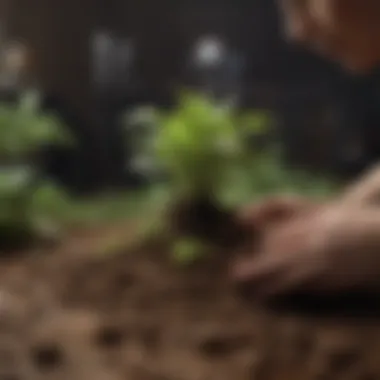
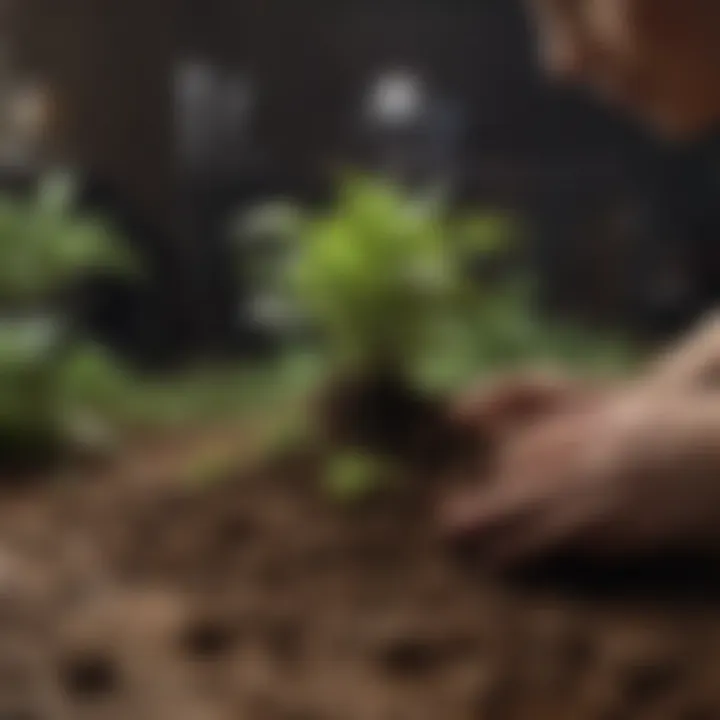
- Pest Control: For minor pest infestations, try natural solutions such as neem oil or insecticidal soap. For persistent issues, consider chemical options, but use them wisely and sparingly.
- Improving Air Circulation: Ensure your plants are not overcrowded. Adequate airflow can help mitigate fungal diseases.
- Adjusting Watering Habits: Know when to water. Investigate if your herbs are receiving too much or too little water. Moisture meters can be helpful.
- Adjusting Environmental Conditions: Increase humidity levels for tropical herbs or ensure proper lighting conditions to boost resilience.
Regular monitoring and proactive measures can significantly enhance the health of your indoor herbs, making pest management and disease prevention a key focus for any indoor gardener.
In summary, while the thought of pests and diseases can be daunting, an informed and vigilant approach helps maintain the health of your indoor herb garden. By recognizing the common culprits and the signs of distress, you can take swift action, ensuring your herbs thrive under your care.
Harvesting and Utilizing Your Indoor Herbs
The culmination of nurturing your indoor herbs lies in the moments of harvest. Harvesting not only represents the tangible rewards of your labor but is also a witness to the growth journey of your plants. This section aims to delve into how timing and technique influence the health of your herbs and the flavorful benefits of utilizing them in your culinary adventures.
When and How to Harvest Herbs
Knowing when to harvest your herbs is just as crucial as cultivating them. Herbs have unique growing patterns, so timing it right is often the key to maximizing flavor. For instance, basil, once it starts to plant flowers, tends to lose its key flavor notes. Ideally, you'd want to catch it before you see flowers peeking through. A gentle reminder here: always cut at least a third of the plant to ensure ongoing growth. This way, you encourage bushier development while still keeping a good supply for your kitchen.
- Early Morning Harvest: The best time to gather your herbs is in the morning. During this period, the essential oils are at their peak, ensuring that your herbs are flavorful and fragrant.
- Use Clean Tools: Sharp scissors or pruning shears will do the trick. A clean cut minimizes stress to the plant, allowing it to continue thriving.
- Cutting Techniques: For leafy herbs like cilantro or parsley, cut the stem just above a leaf node. This encourages branching and more growth. In contrast, for woody herbs like rosemary, cut the stems instead of merely harvesting leaves.
Remember, harvesting is not just a one-time affair; it's an art of constant engagement with your plants, maintaining a rhythm that matches their growth.
Culinary Uses of Homegrown Herbs
Once you've gathered your fresh herbs, the culinary possibilities are as varied as the plants themselves. Homegrown herbs elevate not just the flavors of your dishes but also their health benefits. Using fresh herbs is a fantastic way to stay connected with the earth and to revel in the vibrant tastes that indoor gardening can deliver.
- Enhancing Flavor: Fresh basil imparts a sweetness to tomato sauces, while rosemary adds a robust depth to roasted meats. Even a sprinkle of thyme can transform a simple vegetable medley into something that dazzles the palate.
- Innovative Beverages: Think beyond the plate. Herbs like mint can create an invigorating iced tea or refreshing mojito. Infused water with cucumber and herbs is also a lovely way to maintain hydration with an extra flavor punch.
- Garnishing: Fresh herbs can act as a beautiful garnish. A few sprigs of cilantro over a dish not only enhance appearance but also impart a bright flavor.
"Homegrown herbs give any meal a personal touch, making you feel like a master chef in your own kitchen."
Incorporating your homegrown herbs is about experimenting and finding what please your taste buds. Whether it's adding to soups, making dressings, or garnishing, let your creativity run wild. Additionally, share these bursting flavors with family and friends, bridging the gap between your indoor garden and communal dining at the table.
With the knowledge of when to harvest and the endless culinary possibilities, your journey of using herbs comes full circle, enriching not just your plates but your lifestyle.
Challenges in Indoor Herb Gardening
Growing herbs indoors can be a rewarding experience, teeming with flavorful surprises and fragrant additions to culinary creations. However, it is not without its bumps along the road. Addressing the challenges in indoor herb gardening becomes essential for enthusiasts who wish to cultivate a thriving herb garden right within their homes. This section examines specific issues that indoor gardeners frequently face and offers practical strategies to overcome these obstacles, shedding light on the nuances of successful herb cultivation.
Common Issues Encountered by Indoor Gardeners
Many budding herb gardeners often find themselves grappling with a handful of common problems. Here are some of those pesky issues:
- Insufficient Light: One of the most prevalent hurdles is inadequate sunlight, as many indoor spaces may not provide enough natural light. Most herbs thrive in direct sunlight, and phasing them in and out of sunny spots can be troublesome.
- Pest Invasion: While indoor gardening seems like a safe haven from pests, insects like aphids or spider mites can still sneak in, posing a threat to the health of the plants.
- Overwatering or Underwatering: It can be a bit tricky to hit the sweet spot for hydration. Overwatering can lead to root rot, while underwatering can dehydrate the plants, giving them a thirsty look.
- Nutrient Deficiencies: Sometimes, herbs just seem to droop despite proper care. This can stem from a lack of adequate nutrients in the soil, resulting in stunted growth and poor flavors.
- Temperature Fluctuations: Indoor environments can often have fluctuating temperatures. Some herbs may not take kindly to excessive warmth or cold drafts.
Recognizing these issues is the first step to better indoor gardening.
Solutions and Tips for Success
Now that we know some common challenges, let’s tackle them with effective solutions:
- Maximizing Light Exposure: Utilize grow lights if natural sunlight is scarce. You can set them on timers to ensure that herbs receive a consistent light schedule. Consider rotating your plants regularly to promote even growth.
- Pest Management: Routinely inspect your herbs for signs of pests. If you spot any intruders, natural remedies like neem oil or insecticidal soap can help. Also, introducing small beneficial insects like ladybugs can naturally control pest populations.
- Water Wisely: Invest in moisture meters to determine when to water and avoid over or under-watering. It’s often better to err on the side of caution and let the soil dry out slightly between waterings.
- Nutrient Boosting: Use quality potting mix enriched with organic fertilizers to provide your herbs with the necessary nutrients. Consider solutions like compost or worm casting as an organic way to enhance soil nutrition.
- Stabilize Temperature: Keep an eye on the thermostat and avoid placing herbs near drafty windows or heat sources. A consistent temperature environment will help your herbs flourish.
"A healthy garden is a happy chore; adjust your methods, and you’re bound to see results."
By acknowledging potential issues and implementing these practical tips and solutions, even the most inexperienced indoor gardeners can cultivate a bountiful herb garden. Challenges don’t have to spell disaster; rather, they can be viewed as stepping stones towards an enriching indoor gardening experience.
End
Wrapping up the journey of indoor herb gardening is like tying the knot on a beautifully crafted tapestry. Each thread symbolizes the various elements we've discussed, from choosing the right herbs to understanding their unique care needs. The importance of this conclusion lies not just in summarizing what's been covered but in reinforcing the notion that cultivating herbs indoors is both an art and a science. With the right knowledge, your indoor space can flourish into a verdant haven, replete with aromatic flavors and health benefits.
Recap of Key Points
As we take a step back and reflect on the essential tips gleaned from this comprehensive guide, several key points stand out:
- Selection of Herbs: Understanding different herb varietals and their growth requirements is critical. Some, like basil and rosemary, thrive under certain conditions, while others may require different environments.
- Light and Temperature: Proper light exposure and maintaining optimal temperatures are vital for successful indoor gardening. LED grow lights can supplement natural lighting for herbs if needed.
- Soil and Water Management: Choosing the right type of soil that drains well and knowing when and how to water your herbs keeps them healthy and productive.
- Pest Control: Knowing common pests and diseases and how to tackle them can save your garden from potential disasters.
- Utilization of Harvested Herbs: Understanding how and when to harvest your herbs not only enhances growth but adds a personal touch to your culinary experiences.
This recap serves as a potent reminder that with attention to these details, you can create a thriving indoor herb garden that is both rewarding and functional.
Final Thoughts on Indoor Herb Gardening
Overall, indoor herb gardening is an endeavor that yields not just fresh flavors in your dishes but also offers a therapeutic escape from the hustle and bustle of daily life. In cultivating herbs, you're engaging in a sustainable practice, reducing food miles, and enjoying herbs that are free from pesticides and chemicals.
However, challenges will arise. Like a gardener facing the changing seasons, adaptability and willingness to learn are essential in overcoming these hurdles. Join the community of fellow indoor gardeners who share insights on platforms like reddit.com and connect with your personal experiences.
Finally, engaging in this practice also nurtures a sense of achievement. Each sprig harvested is not just a culinary addition—it's a testament to your dedication and passion for nurturing life in a confined space. So, roll up your sleeves and embark on this rewarding journey. Your indoor herb garden awaits.















